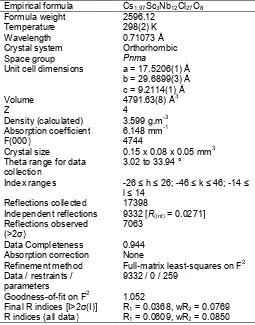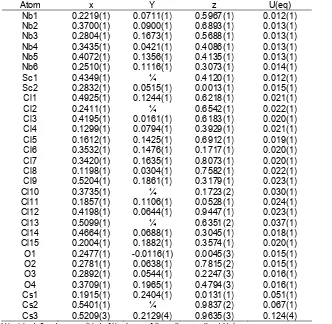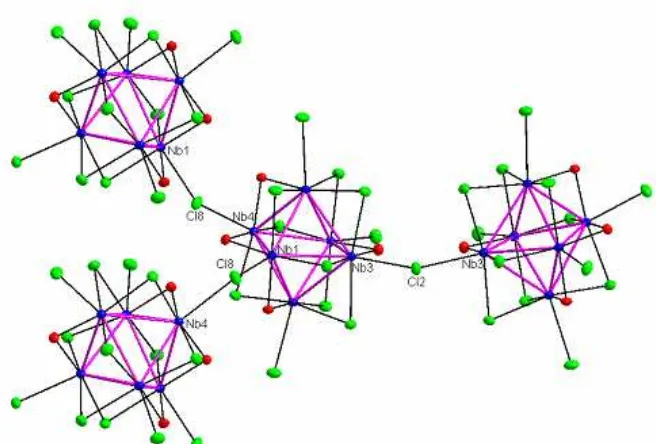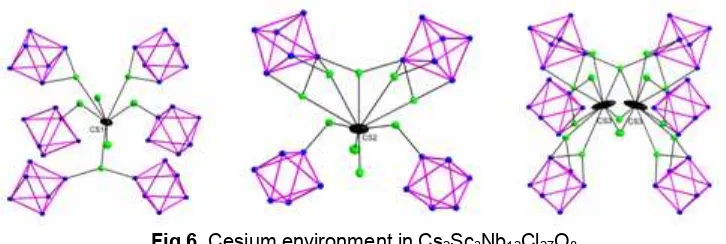A NOVEL OCTAHEDRAL NIOBIUM OXYCHLORIDE CLUSTER BUILT FROM
INTERCONNECTED Nb
6Cl
12O
4UNITS: Cs
2Sc
3Nb
12Cl
27O
8Fakhili Gulo
Department of Chemical Education, FKIP Universitas Sriwijaya Jalan Palembang-Prabumulih Km 32 Indralaya, OI 30662
Received December 21, 2011; Accepted May 18, 2011
ABSTRACT
A novel octahedral niobium cluster oxychloride compound, Cs2Sc3Nb12Cl27O8 was synthesized by solid-state
route techniques from stoichiometric mixture of CsCl, Sc2O3, Nb, NbCl5, and Nb2O5, heated at 700 °C for two days.
The crystal structure was determined by single crystal X-ray diffraction method. It crystallizes in orthorhombic system with space group of Pnma, a = 17.5206(1) Å, b = 29.6899(3) Å, c = 9.2114(1) Å, and V = 4791.63(8) Å3. The
structure is based on
-6 8 4 3/ 2 3
( i i) a a a
Nb Cl O Cl Cl unit in which four oxygen ligands selectively occupy inner positions arranged in sets of three and one on opposite side of the Nb6 octahedron. Each cluster shares three apical-chlorine
ligands with three adjacent clusters to form layers with topology similar to that of graphite. The cluster units are also connected to each other by both cesium and scandium atoms to form a three-dimensional framework. This compound exhibits 14 valence electrons per cluster.
Keywords:cluster compound, crystal structure, valence electron
INTRODUCTION
The early transition elements favor the formation of metal-metal bonds in their compounds with low oxidation states and display a propensity for forming hexanuclear clusters based on an octahedral arrangement of metal atoms [1]. A cluster can be defined as an aggregate of metallic atoms with finite dimension and high symmetry, in which the metallic atoms are linked together by metal-metal bonds [2]. In the cluster core, the distances between metallic atoms are close to those in the metal bulk. The most common structural units in these compounds are octahedral unit of i a
6 8 6
(M L )L and i a
6 12 6
(M L )L in which the inner ligands (Li) cap the faces or bridge the edges of the metal octahedron, respectively, and the apical ligands (La) are located in the terminal positions.
The increasing interest in transition metal cluster compounds encountered this last decade is due to their fascinating basic aspects of structures, remarkable physical properties as superconductivity, ionic conductivity, catalytic activity, and various applications [3]. Indeed, some of these compounds are now well known for their unusual physical properties in AxMo6L8 (A = Pb, Sn, Cu, Li, La, Eu, etc.; L=S, Se, Te) that turned out to be a superconductor at 14 K [4-5]. The ultimate condensation of the i a
6 12 6
(Nb O )O units, observed in the
NbO i-i-i-i
6/2 1 2/4
(Nb O ) binary compound, induces transport properties with a superconducting transition at low temperature [6]. These cluster compound types could be
used as precursors for the synthesis of organomineral hybrids [7] and inorganic polymeric cluster materials of different dimensionality [8-9] via soft chemistry.
The octahedral clusters of niobium tend to adopt structures with edge-bridged octahedral geometry, Nb6L18 cluster unit in which an octahedron of niobium atoms surrounded by twelve inner ligands (Li) and six apical ligands (La). A large number of binary, ternary, and quaternary compounds based on the Nb6L18 (L = Cl, Br or O) cluster units have been reported [9-10]. Each compound, in which discrete or interconnected units are encountered, possesses its own electronic and structural features in relation with the nature of ligands bonded to Nb6cluster.
Table 1. Crystal data and structure refinement for
Unit cell dimensions a = 17.5206(1) Å b = 29.6899(3) Å c = 9.2114(1) Å
Volume 4791.63(8) Å3
Z 4
Density (calculated) 3.599 g.m-3 Absorption coefficient 6.148 mm-1
F(000) 4744
Independent reflections 9332 [R(int)= 0.0271]
Reflections observed (>2σ)
7063
Data Completeness 0.944
Absorption correction None
Refinement method Full-matrix least-squares on F2 Data / restraints /
parameters
9332 / 0 / 259
Goodness-of-fit on F2 1.052
Final R indices [I>2σ(I)] R1= 0.0368, wR2= 0.0769
R indices (all data) R1= 0.0609, wR2= 0.0850
The discovery of the first Nb6 oxychloride, ScNb6Cl13O3 [15] opened the field of a new class of octahedral niobium cluster compounds by using a combination of ligands. Modification of the cluster units by introduction of both halogen and oxygen as ligands can lead to changes in electronic configuration, charge, and symmetry, and is, therefore, conducive to formation of new structural types.
Herein, we report the structure of a novel octahedral niobium cluster oxychloride compound, Cs2Sc3Nb12Cl27O8 with mixed-ligands of oxygen and chlorine. This new compound contains four oxygen inner ligands and exhibits valence electron counts of 14 per cluster.
EXPERIMENTAL SECTION
Materials
In this experiment, we used the following materials: Nb powders (Ventron, m2N8), CsCl, Sc2O3 (Alfa, 99.5%), NbCl5 (Alfa, 99.9%), Nb2O5 (Alfa, 99.5%),
Nitrogen liquid, oxygen gas, hydrogen gas, and silica tube.
Instrumentation
The used instrumentations in this experiment are glove box, analytical balance, tube furnace, scanning electron microscope (SEM), and Nonius KappaCCD X-ray diffractometer.
Procedure
Synthesis
The compound, Cs2Sc3Nb12Cl27O8 was synthesized at high-temperature reaction of stoichiometric amounts of Nb powders (Ventron, m2N8), CsCl, Sc2O3(Alfa, 99.5%), NbCl5(Alfa, 99.9%), and Nb2O5 (Alfa, 99.5%). The mixture was prepared in glove box under argon atmosphere, sealed under vacuum in silica tube, and heated at 700 °C for two days. The Cs2Sc3Nb12Cl27O8 phases were obtained as black crystals. The elemental composition of the products was derived from single crystal X-ray diffraction analysis and confirmed by energy-dispersive X-ray analysis performed on single crystals.
Crystal X-ray Data Collection
A suitable single crystal of Cs2Sc3Nb12Cl27O8 was selected and used for structural determination by X-ray diffraction. Intensity data were collected at room temperature by a Nonius KappaCCD diffractometer with MoKα radiation (λ = 0.71073 Å). A crystal-to-detector distance of 25 mm was applied and data collection strategy was performed by using the COLLECT program of KappaCCD software package to measure all the Bragg reflections inside the full sphere until θ = 33.94°. A total of 17,398 reflections were collected with ΔΦ = 2° rotation scans and Δω = 2° rotation scans to fill the asymmetric unit cell (exposition time = 30 sec/deg). Finally, 9,332 reflections were indexed, Lorentz-polarization corrected, and then integrated in the orthorhombic symmetry by the DENZO program of the KappaCCD software package.
Structural Determination
Table 2.Atomic coordinates and equivalent isotropic displacement parameters (Å2) for Cs2Sc3Nb12Cl27O8
Atom x Y z U(eq)
Nb1 0.2219(1) 0.0711(1) 0.5967(1) 0.012(1)
Nb2 0.3700(1) 0.0900(1) 0.6893(1) 0.013(1)
Nb3 0.2804(1) 0.1673(1) 0.5688(1) 0.013(1)
Nb4 0.3435(1) 0.0421(1) 0.4086(1) 0.013(1)
Nb5 0.4072(1) 0.1356(1) 0.4135(1) 0.013(1)
Nb6 0.2510(1) 0.1116(1) 0.3073(1) 0.014(1)
Sc1 0.4349(1) ¼ 0.4120(1) 0.012(1)
Sc2 0.2832(1) 0.0515(1) 0.0013(1) 0.015(1)
Cl1 0.4925(1) 0.1244(1) 0.6218(1) 0.021(1)
Cl2 0.2411(1) ¼ 0.6542(1) 0.022(1)
Cl3 0.4195(1) 0.0161(1) 0.6183(1) 0.020(1)
Cl4 0.1299(1) 0.0794(1) 0.3929(1) 0.021(1)
Cl5 0.1612(1) 0.1425(1) 0.6912(1) 0.019(1)
Cl6 0.3532(1) 0.1476(1) 0.1717(1) 0.020(1)
Cl7 0.3420(1) 0.1635(1) 0.8073(1) 0.020(1)
Cl8 0.1198(1) 0.0304(1) 0.7582(1) 0.022(1)
Cl9 0.5204(1) 0.1861(1) 0.3179(1) 0.023(1)
Cl10 0.3735(1) ¼ 0.1723(2) 0.030(1)
Cl11 0.1857(1) 0.1106(1) 0.0528(1) 0.024(1)
Cl12 0.4198(1) 0.0644(1) 0.9447(1) 0.023(1)
Cl13 0.5099(1) ¼ 0.6351(2) 0.037(1)
Cl14 0.4664(1) 0.0688(1) 0.3045(1) 0.018(1)
Cl15 0.2004(1) 0.1882(1) 0.3574(1) 0.020(1)
O1 0.2477(1) -0.0116(1) 0.0045(3) 0.015(1)
O2 0.2781(1) 0.0638(1) 0.7815(2) 0.015(1)
O3 0.2892(1) 0.0544(1) 0.2247(3) 0.016(1)
O4 0.3709(1) 0.1965(1) 0.4794(3) 0.016(1)
Cs1 0.1915(1) 0.2404(1) 0.0131(1) 0.051(1)
Cs2 0.5401(1) ¼ 0.9837(2) 0.067(1)
Cs3 0.5209(3) 0.2129(4) 0.9635(3) 0.124(4)
U(eq) is defined as one third of the trace of the orthogonalized Uijtensor
The final refinement cycles converged to R1=0.0368, wR2=0.0769 for I>2σ(I) and R1=0.0609, wR2=0.0850 for all data with highest peak of 3.49 at 0.72 Å from Sc1 site and Goodness-of-fit onF2of 1.052. Details of data collection and structure refinement are summarized in Table 1. Atomic positions and equivalent isotropic displacement parameters are reported in Table 2. Selected interatomic distances are listed in Table 3. Anisotropic thermal factors and observed and calculated structure factors are available from the authors upon request.
RESULT AND DISCUSSION
In this paper, we describe and discuss the novel cluster oxychloride compound, Cs2Sc3Nb12Cl27O8. This compound crystallizes in an original structure type of orthorhombic system with space group of Pnma. The Nb6 cluster is built from six crystallographically independent niobium atoms lying in a pyramidal site of ligands. One Nb atom has coordination spheres of two inner-chlorines (Cli), two inner-oxygens (Oi), and one apical-chlorine (Cla) ligands and five Nb atoms are surrounded by two Cli, two Oi, and one Claligands. Each
octahedral Nb6 cluster of this compound contains four oxygen and eight chlorine ligands at inner position and six chlorine ligands at terminal position. The main building block of the compound is an octahedral cluster
unit of i i a
6 8 4 6
(Nb Cl O )Cl . In this cluster unit, four oxygen ligands selectively occupy inner positions arranged in sets of three ‘triad’ and one on opposite side of the Nb6 octahedron (Fig. 1).
The octahedral niobium cluster oxychlorides with four oxygen ligands were also encountered in the structure of [Tl5(Ti2Cl9)][(Nb6Cl12O4)3(Ti3Cl4)2] [18], Ti2Nb6Cl14O4 [19], and CsNb6Cl12O2 [20]. However in contrast to Cs2Sc3Nb12Cl27O8, the O
i
Table 3.Selected interatomic distances [Å] for Cs2Sc3Nb12Cl27O8 Nb6cluster
Nb1-Nb2 2.7884(4) Nb2-Nb5 2.9506(4)
Nb1-Nb3 3.0447(5) Nb3-Nb5 2.8062(4)
Nb1-Nb4 2.8773(4) Nb3-Nb6 2.9680(4)
Nb1-Nb6 2.9672(4) Nb4-Nb5 2.9901(5)
Nb2-Nb3 2.9952(5) Nb4-Nb6 2.7835(5)
Nb2-Nb4 2.9864(4) Nb5-Nb6 2.9937(4)
Nb6cluster environment
Nb1-Cl4 2.4868(9) Nb4-Cl3 2.4704(9)
Nb1-Cl5 2.5264(10) Nb4-Cl8 2.6407(10)
Nb1-Cl8 2.6226(9) Nb4-Cl14 2.4858(9)
Nb1-O1 2.032(3) Nb4-O1 2.038(2)
Nb1-O2 1.978(2) Nb4-O3 1.977(2)
Nb2-Cl1 2.4570(10) Nb5-Cl1 2.4536(9)
Nb2-Cl3 2.4467(10) Nb5-Cl14 2.4521(9)
Nb2-Cl7 2.4868(10) Nb5-Cl6 2.4460(9)
Nb2-Cl12 2.6217(9) Nb5-Cl9 2.6374(10)
Nb2-O2 1.979(2) Nb5-O4 2.011(3)
Nb3-Cl2 2.6676(6) Nb6-Cl4 2.4554(10)
Nb3-Cl5 2.4854(9) Nb6-Cl6 2.4315(10)
Nb3-Cl7 2.4502(9) Nb6-Cl11 2.6084(9)
Nb3-Cl15 2.4783(9) Nb6-Cl15 2.4840(10)
Nb3-O4 1.985(2) Nb6-O3 1.977(3)
Scandium environment
Sc1-Cl9 2.5689(11)x2 Sc2-Cl11 2.4943(12)
Sc1-Cl10 2.4560(17) Sc2-Cl12 2.4778(12)
Sc1-Cl13 2.4395(18) Sc2-O1 1.976(3)
Sc1-O4 2.042(3)x2 Sc2-O2 2.060(2)
Sc2-O3 2.062(2)
Cesium environment
Cs1-Cl2 3.4304(14) Cs2-Cl9 3.6324(18)
Cs1-Cl7 3.9712(14) Cs2-Cl9 3.6324(18)
Cs1-Cl9 3.7436(13) Cs2-Cl15 3.6606(19)
Cs1-Cl9 4.0215(14) Cs3-Cl5 3.527(5)
Cs2-Cl10 3.396(2) Cs3-Cl6 4.010(8)
Cs1-Cl13 3.4730(19) Cs3-Cl9 3.360(3)
Cs1-Cl15 3.8183(13) Cs3-Cl10 3.402(3)
Cs2-Cl2 3.745(2) Cs3-Cl15 3.626(3)
Interatomic shortest
Cs1-Cs1 0.569(3)
Cs2-Cs3 1.165(12)
Cs3-Cs3 2.20(2)
Fig 1. The octahedral cluster unit
(Nb
6Cl
8iO
4i)Cl
a6 in Cs2Sc3Nb12Cl27O8In Cs2Sc3Nb12Cl27O8, the Nb6 octahedron is significantly distorted due to the steric effect of the mixed-ligands. The Nb–Nb distances for oxygen-bridged edges are 2.7835(5) Å to 2.8773(4) Å, and those for chlorine-bridged edges range from 2.9672(4) Å to 3.0447(5) Å (Table 3). These bond lengths are similar to those found in the other niobium cluster oxychloride compounds and are also consistent with the presence of 14 valence electrons per cluster [9].
Linkage between the cluster units is made by sharing the apical-chlorine ligands between two adjacent units. Each cluster shares three of its six apical-chlorine ligands with three adjacent clusters with connectivity formula of i i a-a a
6 8 4 3/2 3
Fig 2.Connection of Nb6cluster with three adjacent clusters with connectivity formula, (Nb Cl O )Cl Cl6 8i 4i a-a3/2 a3
Fig 3.A view of cluster layers with graphite-topology inbc-plane for Cs2Sc3Nb12Cl27O8
linkages lead to form layers with topology similar to that of graphite as found in the structure of Na0.21Nb6Cl10.5O3 [21] with connectivity formula of (Nb Cl O6 9i 3/2i-a)O Cla-i3/2 a-a3/2. In Na0.21Nb6Cl10.5O3, the six-member cluster rings are constructed by inner-apical oxygen ligands while in Cs2Sc3Nb12Cl27O8, those are built by apical-apical chlorine ligands. In the bc plane, adjacent clusters are bridged through outer chlorine ligands. The cluster linkages in the a-direction are constructed by cesium and scandium atoms.
Fig 4.A view of the crystal structure of Cs2Sc3Nb12Cl27O8in the [001] direction with zig-zag chains
Fig 6.Cesium environment in Cs2Sc3Nb12Cl27O8
second scandium atom, Sc2 links three clusters and has environment of unusual trigonal-bipyramidal geometry formed by three inner-oxygen ligands and two apical-chlorine ligands. The same environment of counter cations was also encountered in the structure of ScNb6Cl13O3 [15] that contain three inner-oxygen ligands.
Adjacent layers in Cs2Sc3Nb12Cl27O8 are related by a plane perpendicular toc-direction and interact through cesium atoms. The cesium atoms are distributed over three independent sites (Cs1, Cs2, Cs3). The site Cs1 is a half occupied and coordinated by 9 chlorines within 4.2 Å. The Cs2 and Cs3 sites, separated by 1.165 Å, are located in the channels running between the layers in the b-direction. These two sites are partially occupied (Cs2: 50%, Cs3: 23%), and also coordinated by 9 chlorines within 4.2 Å. The number of cesium atoms per cluster was refined to 0.99(2) which agrees with the oxidation states assigned to the transition metals.
The structural properties of the novel niobium cluster oxychloride, Cs2Sc3Nb12Cl27O8 demonstrate the effectiveness of using mixed-ligands to prepare low-dimensional materials. The ordered oxygen and chlorine ligands distribution leads to great distortions of the cluster and to various electronic counts. The physical properties of the cluster compounds are related to the strength of interaction between cluster units and the number of electrons available for metal-metal bonding, the so-called valence electron count (VEC).
From the structural data, the VEC per cluster calculated for Cs2Sc3Nb12Cl27O8is 14. This VEC value is confirmed by the average Nb-Nb intracluster distance that is shorter for Cs2Sc3Nb12Cl27O8 than those for CsNb6Cl12O2 (VEC = 15) [20] and Cs2LuNb6Cl17O (VEC = 16) [23]. Indeed, if we consider only the size effect of Oi on the cluster, we should expect a smaller average Nb-Nb bond length for Cs2Sc3Nb12Cl27O8with four O with only one Oi per unit, but in fact it is the opposite. This feature is easily explained by the predominant effect of the VEC value of 15 in the case of ANb6Cl12O2 (A = Cs, Rb) [20-22], instead of 16 for Cs2LuNb6Cl17O. Indeed, this lower VEC value corresponds to a
weakening of the Nb-Nb intracluster bonds because one electron is removed from Nb-Nb bonding states, and thus to an increasing of the corresponding bond lengths.
The partial population of the ‘a2u’ state in ANb6Cl12O2is consistent with the trend that the number of valence electrons decreases as the chlorine ligands in Nb6Cl18 clusters are progressively substituted by oxygen [23]. The most stable electronic configuration in these clusters is determined by the balance between Nb–Nb bonding and Nb–Li antibonding contributions to the ‘a2u’ state. The identity of the apical ligands does not affect the character of the ‘a2u’ level, because they do not contribute to this state. In niobium chlorides, the ‘a2u’ state is generally fully occupied, leading to 16 valence electrons per cluster. In the oxides, the stronger Nb–Oi interaction results in an overall antibonding character of the ‘a2u’ level and a typical VEC of 14.
Most oxychloride cluster compounds with three to six inner oxygen ligands have VEC of 14 [9], indicating the dominating influence of the oxygen ligands. In contrast, the compound Cs2LuNb6Cl17O with one oxygen ligand per cluster has VEC of 16 as in most chloride clusters. The cluster unit with two inner oxygen ligands, such as that in CsNb6Cl12O2, represents, probably, an intermediate case in which the addition of electrons to the ‘a2u’ state neither decreases nor increases the stability of the cluster. This could account for the observed variations in the composition of the title series. Thus, from the electronic point of view, the cluster framework can be expected to be stable with VEC of 14, i.e. without the presence of Cs+ cations. However, we did not succeed in preparing the ternary Nb6Cl12O2 by high-temperature techniques, which may imply that the Cs+cations are required for the formation of the framework and act as templates.
In conclusion, a novel octahedral niobium cluster oxychloride compound, Cs2Sc3Nb12Cl27O8 was obtained by solid-state reaction. Its crystal structure is
based on i i a-a a
6 8 4 3/2 3
octahedron. Each cluster shares three of its six apical-chlorine ligands with three adjacent clusters to form layers with topology similar to that of graphite. The arrangement of ligands favors the formation of zig-zag chains in which the clusters are linked through the scandium atoms and apical-chlorine ligands. This compound exhibits valence electron counts of 14 per cluster.
CONCLUSION
A novel octahedral niobium cluster oxychloride compound, Cs2Sc3Nb12Cl27O8 was obtained by solid-state reaction. Its crystal structure is based on
i i a-a a 6 8 4 3/2 3
(Nb Cl O )Cl Cl in which four oxygen ligands selectively occupy inner positions arranged in sets of three and one on opposite side of the Nb6 octahedron. Each cluster shares three of its six apical-chlorine ligands with three adjacent clusters to form layers with topology similar to that of graphite. The arrangement of ligands favors the formation of zig-zag chains in which the clusters are linked through the scandium atoms and apical-chlorine ligands. This compound exhibits valence electron counts of 14 per cluster.
ACKNOWLEDGEMENT
Author would like to thank Prof. C. PERRIN for advice and helpful discussions during this work that was partially done at LCSIM Université de Rennes 1, France. Acknowledgements are also addressed to Dr. Thierry Roisnel for crystal data collection and to Dr. Stephane Cordier for discussion on structural refinement from Université de Rennes 1, France.
REFERENCES
1. Perrin, C., 2000, “M6L14 and M6L18 Units in Early Transition Element Cluster Compounds” in Metal Clusters in Chemistry. Eds.: Braunsten, P., Oro, L.A., and Raithby, P.R., Wiley-VCH, Wienheim, 1564–1590.
2. Perrin, C., 1997,J. Alloys Comp.,262, 1, 10–21. 3. Simon, A., 1994, “Discrete and Condensed
Transition Metal Clusters in Solids” in Clusters and Colloids – From Theory to Applications. Ed. Schmidt, G., VCH Verlagsgesellschaft mbH, Weinheim, 373– 458.
4. Chevrel, R., Sergent, M., and Prigent, J., 1971,J. Solid State Chem.,3, 4, 515–519.
5. Fisher, Ø., and Maple, M.P., 1982, “Superconducting Ternary Compounds: Prospects and Perseptives” in Topics in Current Physics: Superconductivity in Ternary Compounds. Eds.: Fisher, Ø., and Maple, M.P., Springer-Verlag, Berlin, 1–24.
6. Brauer, G., 1941,Z. Anorg. Allg. Chem., 248, 1, 1– 31.
7. Yaghi, O.M., Scott, M.J., and Holm, R.H., 1992, Inorg.Chem. 31, 23, 4778–4784.
8. Naumov, N.G., Cordier, S., and Perrin, C., 2002, Angew. Chem. Int. Ed., 41, 16, 3002–3004.
9. Naumov, N.G., Cordier, S., Gulo, F., Roisnel, T., Fedorov, V.E., and Perrin, C., 2003, Inorg. Chim. Acta,350, 503–510.
10. Cordier, S., Gulo, F., and Perrin, C., 1999, Solid State Sci.,1,637–646.
11. Gulo, F., Cordier, S., and Perrin, C., 2001, Z. Kristallogr. - New Cryst. Struct., 216, 1, 187–188. 12. Köhler, J., Tischtau, R., and Simon, A., 1991, J.
Chem.Soc.,Dalton Trans., 829.
13. Sägebarth, M.E., Simon, A., Imoto, H., Weppner, W., and Kliche, G., 1995,Z.Anorg.Allgem.Chem., 621, 9, 1589–1596.
14. Xu, J., Emge, T., and Greenblatt, M., 1996,J.Solid State Chem., 123, 1, 21–29.
15. Cordier, S., Perrin, C., and Sergent, M., 1994,Eur. J. Solid State Inorg. Chem., 31, 1049–1054. 16. Sheldrick, G.M., 1997, SHELXS-97, Crystal
Structure Solution, University of Göttingen.
17. Sheldrick, G.M., 1997, SHELXL-97, Crystal Structure Refinement, University of Göttingen. 18. Anokhina, E.V., Day, C.S., Essig, M.W., and
Lachgar, A., 2000, Angew. Chem. Int. Ed., 39, 6, 1047–1049.
19. Anokhina, E.V., Essig, M.W., and Lachgar, A., 1998,Angew. Chem., Int. Ed., 37, 4, 522–525. 20. Gulo, F., and Perrin, C., 2000,J. Mater. Chem.,10,
7, 1721–1724.
21. Gulo, F., and Perrin, C., 2002, J. Solid State Chem.,163: 1, 325–331.
22. Gulo, F., 2008,Indo. J. Chem.,8, 1, 7–12.
23. Cordier, S., Perrin, C., and Sergent, M., 1996,Mat. Res. Bull.,31, 6, 683–690.


![Table 3. Selected interatomic distances [Å] for Cs2Sc3Nb12Cl27O8 cluster](https://thumb-ap.123doks.com/thumbv2/123dok/872216.820864/4.595.67.488.122.702/table-selected-interatomic-distances-a-for-cs-cluster.webp)

![Fig 4. A view of the crystal structure of Cs2Sc3Nb12Cl27O8 in the [001] direction with zig-zag chains](https://thumb-ap.123doks.com/thumbv2/123dok/872216.820864/6.595.120.488.405.741/fig-view-crystal-structure-cs-sc-direction-chains.webp)
